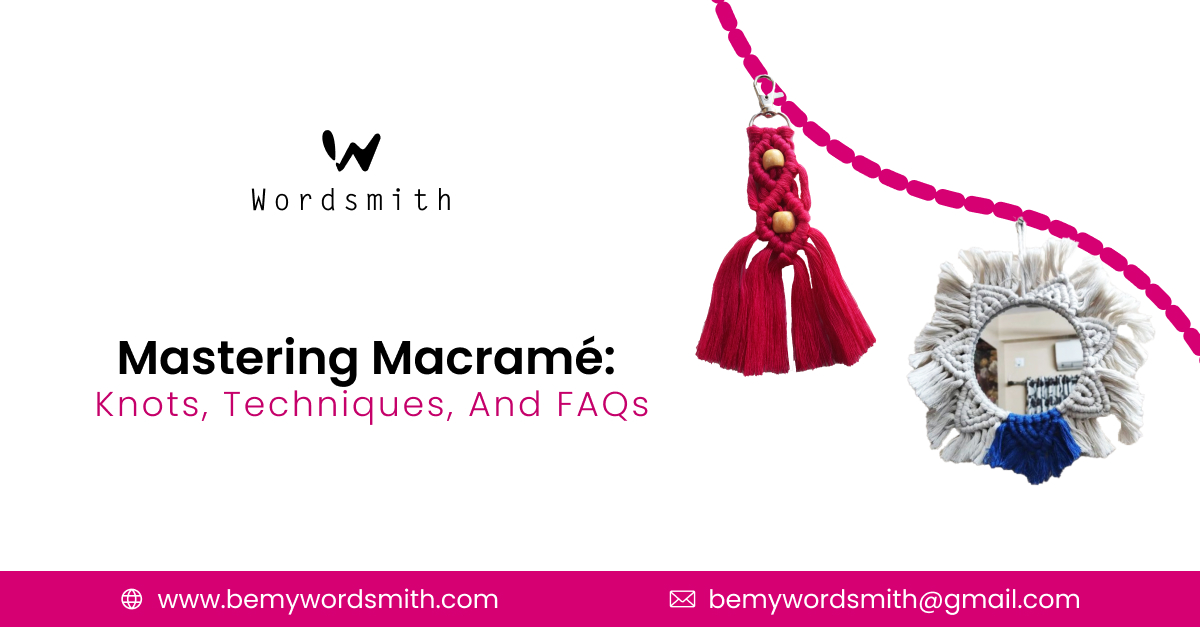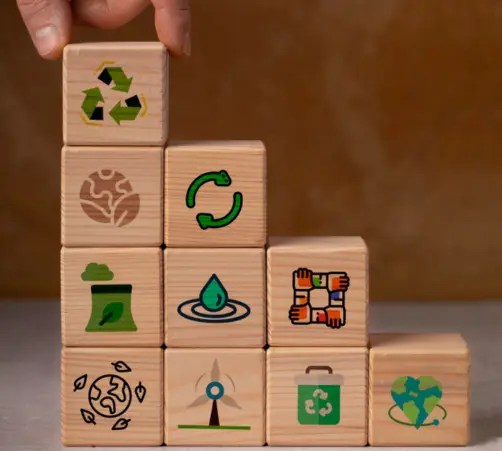Mastering Macramé: Knots, Techniques, and FAQs
Renu S | 01-07-2024 | 05 min read

Since ancient times, macramé has gained popularity as a technique for creating textiles and other decorations that employ a variety of knots to create a simple shape. It is a quick and inexpensive method to decorate your house and add flair.
There are countless ways to combine different kinds of knots to make objects that are both aesthetically pleasing and useful. The word "macramé" is Arabic and means "knotting crossways."
One of the best things I liked about this art form is that it doesn’t require any specific tools to make this art. Your hands and fingers are enough to make this.
This art can be used for plant hangers, clothing, wall hangings, dream catchers, necklaces, bracelets, earrings, curtains, tablecloths, coasters, tassels, keychains, bookmarks, belts, beachwear, etc. - the possibilities are endless.
One can enhance their product with seashells, beads, charms, and other embellishments. Once individuals have mastered the fundamental macramé knots, they may look for more intricate ones online or create their own.
To make products, one can use various colored and sized cords. Options for materials include jute, ribbon, cotton rope, leather strips, yarn, nylon cord, and the increasingly popular hemp cord.
One of the essential factors that people need to consider while buying cords is the strength of the cord. The manufacturing process—specifically, whether the individual thread used to form the material was twisted or braided—significantly impacts the cable's strength. Nylon, leather, jute, and hemp are a few of the strongest.
Many people use it as a method of meditation or just as a way to express their creativity. Over time, macramé evolved into items that were used to adorn clothing and interior spaces. It might start out with basic patterns and grow into quite complex ones.
Types of Cords:
- Rope: The most popular choice for tasks involving Macrame is rope. It gains additional strength and thickness via the twisting of several threads around one another. There are other varieties, such as six-ply braided ropes and three-ply twisted ropes. Macrame rope twists into unusually thick knots that are difficult to untwist.
- String: A string is made up of numerous tiny fibers twisted together to form a single strand. It is, therefore, far softer than macrame rope. One can tie much smaller, tighter knots with string.
- Yarn: Generally utilized for knitting or weaving, yarn may also be worked into macrame designs. It is typically (but not always) composed of industrial hemp and wool, and it may have many strands twisted together.
- Waxed Cord: Usually with a smaller diameter, waxed cord is used for macramé jewellery. Its beeswax coating gives it strength and water resistance; the rope can be plyed or unplyed. It is available in a variety of colors, although wax tends to darken the hues.
Knots
There are more than 50 types of knots, but the most commonly used knots are seven to ten in number. Examples are Larks Head knots, Square knots, Spiral knots, Double Half Hitch Knots, Gathering Knots, Reversed Lark's Head Knots, and Overhand Knots. To learn each knot, there is a video on YouTube that explains each knot in detail.
FAQ - Answers based on my personal experience
Can anyone learn the Macrame Skill?
Yes, anyone who is interested in learning new art skills can learn Macrame. I did not knew what Macrame is all about until I joined the workshop.
Are any prior skills required to learn Macrame?
No prior skill is required.
Which mode is best to learn Macrame – Online or offline?
I found both modes fine for learning Macrame. My first experience was online, while my second one was offline. It depends upon the artist who is teaching the art. How much she knows about the art and everything related to it. If I had to choose, my online experience have been much better than my offline experience.
Where to get the kit from?
Kits are provided by the person holding the workshop at an additional cost. However, one can arrange to hunt local shops as well; this will help them understand the raw material availability in their area when they are planning to do more projects in Macrame.
What type of cords do I use for Macrame projects?
Types of cords depend upon the project one is making. Basically, at the initial stage, most of the workshop uses single-strand cords. It is used to check if students can handle the cords easily or not. But with practice and experience, one can choose their cords as per the project they are making, for example, 3ply braided cords for making bags, belts, plant hangers, clothing, wall hangings, dream catchers, earrings, curtains, tablecloths, coasters, keychains, bookmarks, beachwear etc.
What are the different types of tools that I will require as a beginner?
The fact that Macrame only requires a few specialized tools or equipment is one of its many advantages. Your own hands are the primary tools here. However, there are a few useful tools that will make Macrame more straightforward.
When creating knots, having support to keep your work in place is always beneficial. You can accomplish this by using something as easy as masking or washi tape to attach cables to your desk (I use masking tape). For little parts, a foam or wire board comes in quite useful.
To secure cords and rope to the board, use strong macrame t-pins or regular sewing pins. Certain foam boards (such as this one) that are carefully made contain slots all the way around the edge to secure cords.
A few common household items are required: a sewing measuring tape or retractable metal DIY tape for measuring your cord; sharp scissors for cutting cords and trimming fringes; a simple plastic comb will work well for brushing out fringes; and depending on the project you are working on, additional components to make your Macrame functional, like wooden rods for wall hangings or metal findings for jewellery making.
Conclusion
My suggestion would be not to buy until you are clear about the art and want to do it in the long run. Till now, I have been using household items to complete my projects. A few basic things that I purchased are cords, keychain loops, earring hoops, and bag loops to continue my practice, and I completed a few of my orders.
Note: Most of your queries will be cleared during the workshop. Such as cutting cords, length required, number of cords required for each project. How to calculate your product price? etc.
For top-notch content writing services designed to maximize conversion, check out Be My Wordsmith.
Popular blogs

The significance of building Personal Branding in Digital Marketing
Building your reputation, image, and online visibility on purpose is known as personal branding. It helps in sh...

Usage of SEO-friendly URLs
The core of your website is its URL, and you may boost website traffic by optimizing it. A URL appears more cre...

How Can HR Drive Sustainability Initiatives in the Organization?
Sustainability is a significant concern in our collective consciousness, especially as we look to the future an...
Submit a Comment